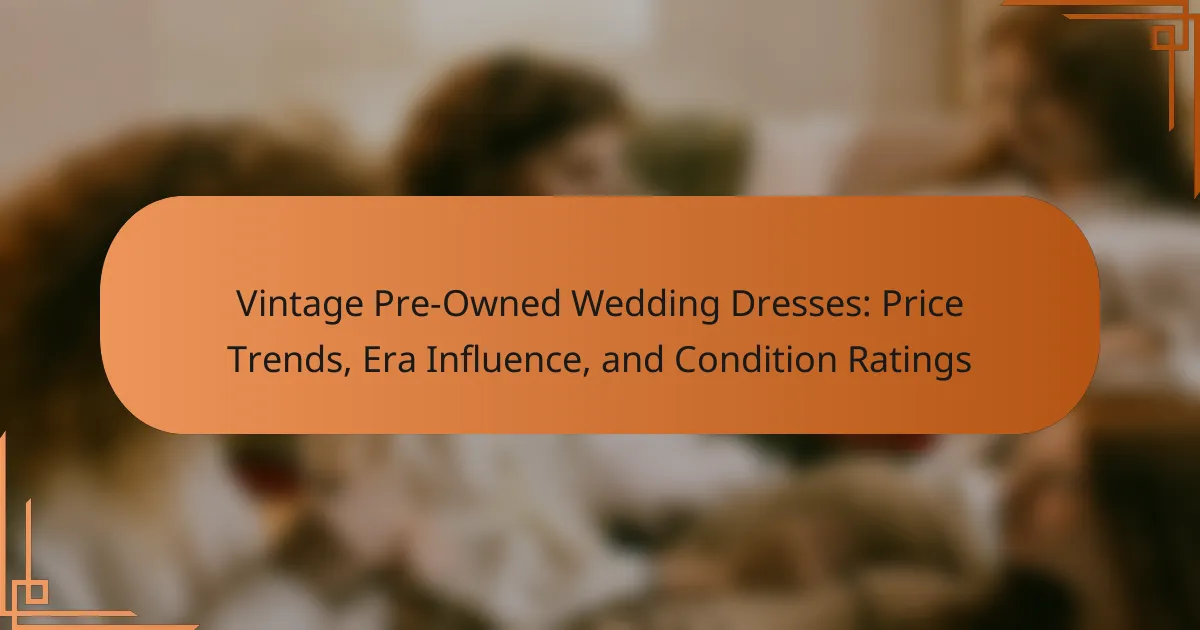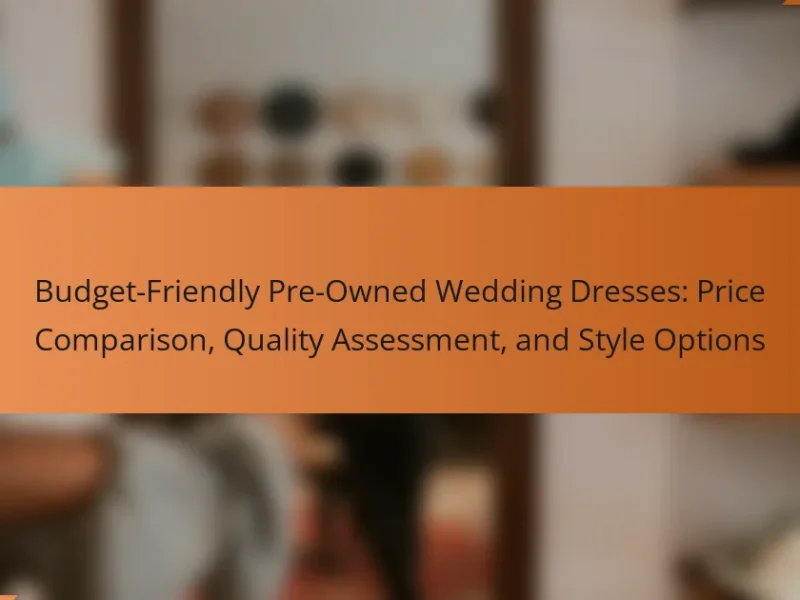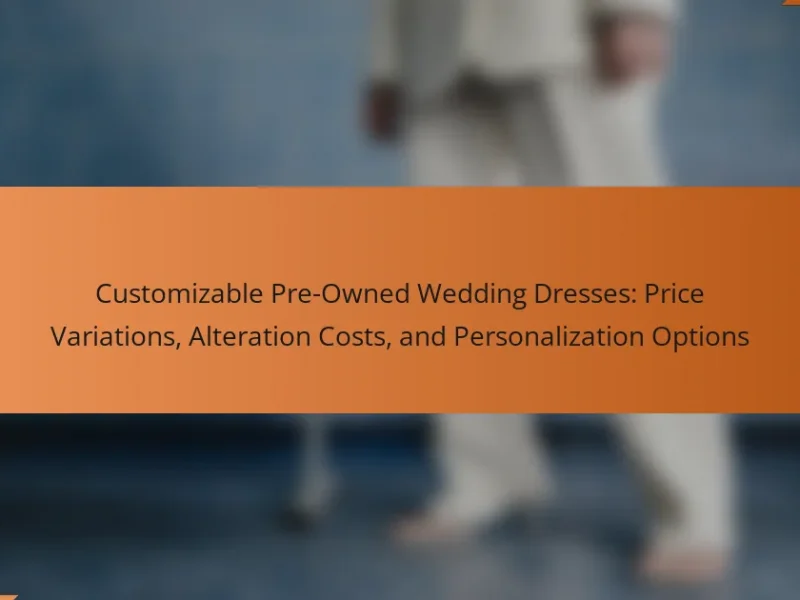Vintage pre-owned wedding dresses are bridal gowns that have been previously owned and originate from earlier fashion eras, showcasing unique design elements and craftsmanship. The article explores the price trends of these dresses, highlighting how factors such as the era, condition ratings, and seasonal demand influence their market value. It also examines how condition ratings reflect the state of wear and preservation, impacting both buyer interest and resale potential. Additionally, the discussion includes insights into the appeal of vintage dresses for brides seeking sustainability and individuality in their wedding attire. Overall, the article provides a comprehensive overview of the vintage wedding dress market, focusing on historical significance, pricing dynamics, and the importance of condition ratings.
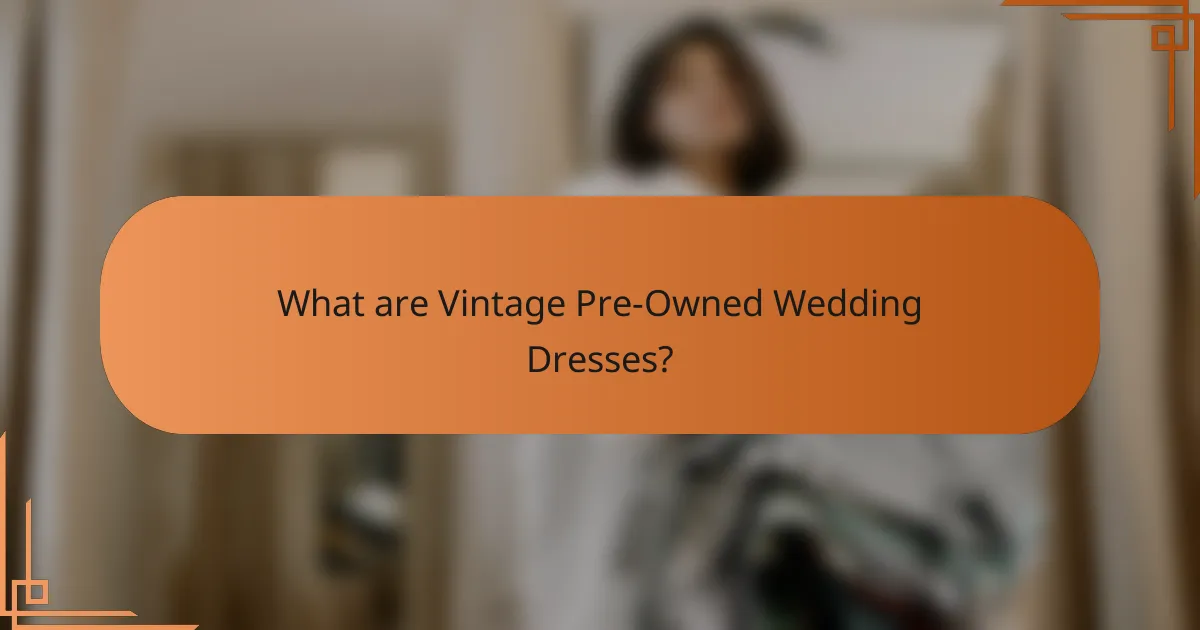
What are Vintage Pre-Owned Wedding Dresses?
Vintage pre-owned wedding dresses are bridal gowns that were previously owned and date back to earlier fashion eras. These dresses often reflect unique design elements and craftsmanship from their respective periods. They can vary significantly in style, fabric, and embellishments, showcasing the fashion trends of the time. Typically, vintage dresses are categorized by the decade they represent, such as the 1920s flapper styles or the 1970s bohemian looks. The appeal of these gowns lies in their history and individuality, offering brides a distinctive alternative to modern designs. Many brides choose vintage pre-owned dresses for sustainability reasons and the opportunity to wear a piece of fashion history. The condition and authenticity of these dresses can affect their market value, making them a unique investment in bridal fashion.
How do we define ‘vintage’ in the context of wedding dresses?
‘Vintage’ in the context of wedding dresses refers to gowns that are at least 20 to 30 years old. This definition typically includes dresses from specific historical periods, such as the 1920s to the 1980s. Vintage wedding dresses often showcase unique styles, fabrics, and craftsmanship reflective of their era. For instance, dresses from the 1950s may feature fuller skirts and intricate lace details. The term ‘vintage’ implies not just age but also a certain level of desirability and quality. Many brides seek vintage dresses for their distinctiveness and nostalgic appeal. Collectors and retailers also classify these dresses based on their historical significance and condition.
What time periods are considered vintage for wedding dresses?
Vintage wedding dresses are typically defined as those made between the 1920s and the 1980s. This range includes several distinct styles and trends. The 1920s saw flapper-inspired designs, while the 1950s featured fuller skirts and fitted bodices. The 1970s introduced bohemian styles and flowing fabrics. Dresses from these decades are often sought after for their unique designs and historical significance. Fashion historians widely recognize this time frame as vintage due to the evolution of styles and materials used in bridal fashion.
What characteristics distinguish vintage wedding dresses from contemporary ones?
Vintage wedding dresses are distinguished from contemporary ones by their design, fabric, and construction techniques. Vintage dresses often feature intricate lacework, beading, and unique silhouettes that reflect the fashion trends of their era. In contrast, contemporary dresses typically emphasize simplicity and minimalism, with clean lines and modern fabrics.
The fabrics used in vintage dresses often include heavier materials like silk and taffeta, while contemporary designs may utilize lighter, more breathable fabrics such as chiffon and organza. Additionally, vintage dresses may have unique historical details, such as high necklines or bell sleeves, that are less common in modern styles.
Construction techniques also differ; vintage dresses are frequently handmade with attention to detail, while contemporary dresses may be mass-produced. This craftsmanship can lead to a distinct character in vintage dresses that is often absent in contemporary designs.
Overall, the characteristics of vintage wedding dresses reflect the cultural and fashion influences of their time, making them unique compared to modern counterparts.
Why are pre-owned wedding dresses gaining popularity?
Pre-owned wedding dresses are gaining popularity due to their affordability and sustainability. Many brides seek cost-effective options without compromising on quality. Purchasing a pre-owned dress can save brides up to 50% compared to new gowns. Additionally, the trend aligns with eco-conscious values, promoting recycling and reducing waste in the fashion industry. The rise of online marketplaces has made it easier to access these dresses. Reports indicate that the secondhand wedding dress market has grown significantly in recent years. This growth reflects changing attitudes towards traditional wedding spending. More brides are prioritizing personal style and unique finds over brand-new dresses.
What are the environmental benefits of choosing pre-owned wedding dresses?
Choosing pre-owned wedding dresses offers significant environmental benefits. It reduces waste by extending the lifecycle of garments. This practice minimizes the demand for new fabric production. Fabric production is resource-intensive, consuming water and energy. By opting for pre-owned dresses, fewer natural resources are depleted. Additionally, it decreases carbon emissions associated with manufacturing and transportation. The fashion industry is a major contributor to pollution. Pre-owned dresses help combat this issue by promoting sustainable consumption. Overall, selecting pre-owned wedding dresses supports environmental conservation efforts.
How do pre-owned dresses compare to new dresses in terms of cost?
Pre-owned dresses are generally more affordable than new dresses. The cost difference can be significant, with pre-owned dresses often priced 30% to 70% lower than their new counterparts. This price reduction is due to factors like depreciation and market demand. For instance, a new designer wedding dress might retail for $2,000, while a similar pre-owned dress could be found for $600 to $1,400. The condition of the dress also influences pricing, with well-maintained pre-owned options often being more sought after. Thus, pre-owned dresses provide a cost-effective alternative for consumers seeking quality and style.
What factors influence the pricing of vintage pre-owned wedding dresses?
The pricing of vintage pre-owned wedding dresses is influenced by several key factors. The age of the dress plays a significant role, as older dresses often carry more historical value. The designer or brand associated with the dress can also affect its price, with renowned designers commanding higher prices. The condition of the dress is crucial; well-preserved dresses fetch more than those with visible wear or damage. Rarity impacts pricing as well; unique or limited-edition dresses are typically more expensive. The fabric and craftsmanship quality contribute to the overall value, with high-quality materials and intricate designs being more sought after. Lastly, market demand can fluctuate, affecting how much buyers are willing to pay at any given time.
How do the dress’s era and designer impact its price?
The dress’s era and designer significantly impact its price. Vintage dresses from renowned designers, like Chanel or Dior, often command higher prices due to brand prestige. Dresses from specific eras, such as the 1920s or 1950s, can also fetch premium prices due to their historical significance.
Market demand influences pricing as well. Certain styles become trendy, increasing their value. For example, a 1980s wedding dress may be more sought after during a revival of vintage fashion.
Rarity plays a crucial role too. Limited edition designs or unique pieces can be priced much higher. Additionally, the condition of the dress affects its value. Well-preserved items generally sell for more than those needing repairs.
In summary, designer reputation, era significance, market demand, rarity, and condition collectively determine the pricing of vintage pre-owned wedding dresses.
What role does the dress’s condition play in determining its value?
The dress’s condition significantly impacts its value. A well-preserved dress retains higher market value. Signs of wear, such as stains or tears, lower its worth. Vintage dresses in pristine condition can sell for 20% to 50% more. Collectors prioritize dresses with minimal alterations or damage. The condition also affects buyer interest and demand. A dress with excellent condition may attract multiple offers. Overall, the dress’s condition is a key factor in its valuation.
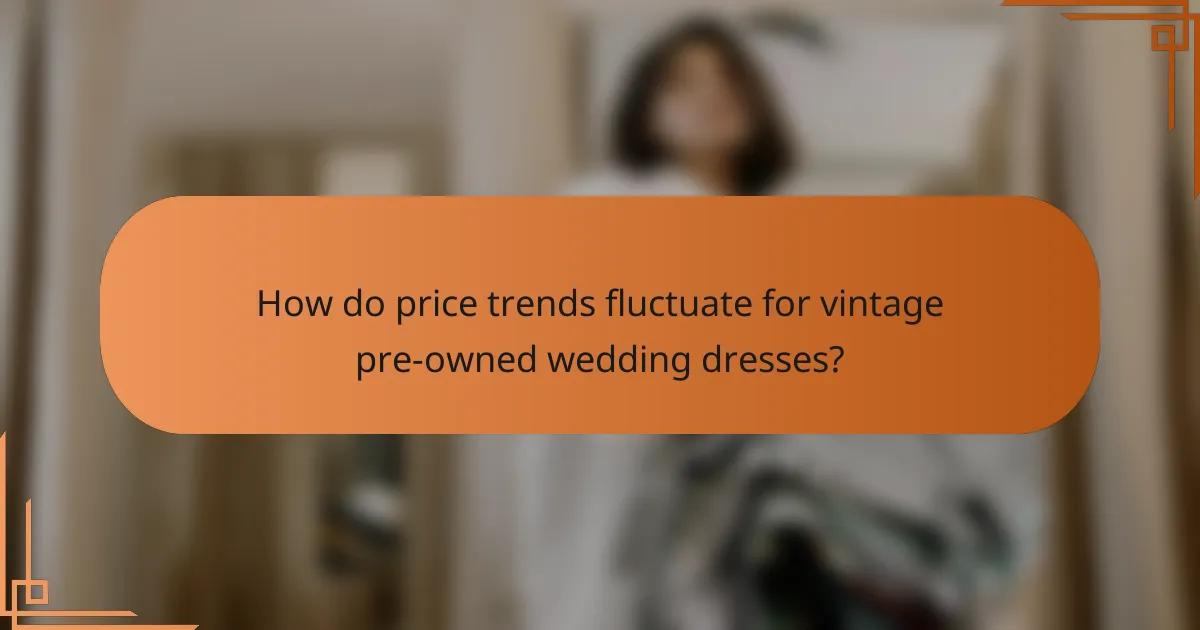
How do price trends fluctuate for vintage pre-owned wedding dresses?
Price trends for vintage pre-owned wedding dresses fluctuate based on several factors. The era of the dress significantly impacts its value. Dresses from popular fashion periods, such as the 1920s and 1980s, often command higher prices. Condition ratings also play a crucial role in determining price. A well-preserved dress can sell for significantly more than one with visible wear. Seasonal demand influences pricing as well. Prices may increase during wedding season and decrease off-season. Market trends and online platforms contribute to price variability. Recent sales data shows that unique designs or designer labels can lead to higher price points. Overall, price fluctuations reflect a combination of historical significance, condition, and market demand.
What are the current market trends for vintage wedding dress prices?
Current market trends for vintage wedding dress prices show an increase in demand and value. Prices for vintage dresses often range from $500 to $3,000. Factors influencing these prices include the dress’s era, designer, and condition. Dresses from the 1920s and 1950s tend to command higher prices. Unique attributes, like intricate beadwork or rare fabrics, can elevate value significantly. Online marketplaces report a 20% rise in average prices over the past year. This trend reflects a growing interest in sustainable fashion choices among brides.
How have prices changed over the past decade?
Prices of vintage pre-owned wedding dresses have generally increased over the past decade. The rise is attributed to growing interest in sustainable fashion and unique styles. According to a 2021 report by The Knot, the average price for vintage wedding dresses rose by approximately 20% from 2011 to 2021. Factors influencing this trend include increased demand for eco-friendly options and a shift towards personalized wedding attire. Additionally, certain eras, like the 1980s and 1990s, have seen even higher price increases due to their nostalgic appeal. The condition of the dress also plays a significant role in pricing, with well-preserved pieces commanding premium prices. Overall, the vintage wedding dress market reflects broader trends in fashion and consumer preferences.
What seasonal factors affect the pricing of vintage wedding dresses?
Seasonal factors significantly affect the pricing of vintage wedding dresses. Demand peaks during wedding seasons, typically spring and summer. Higher demand often leads to increased prices. Conversely, off-peak seasons like fall and winter see lower prices due to reduced buyer interest. Seasonal trends in fashion also influence pricing. For example, popular styles in a given season may command higher prices. Additionally, availability of specific designs can vary seasonally, impacting pricing further. Historical data indicates that dresses in high demand months can be priced 20% to 30% higher than in off-peak months.
How does the rarity of a dress influence its price?
The rarity of a dress significantly influences its price. Rare dresses often command higher prices due to limited availability. Collectors and buyers value unique pieces. This demand drives prices up. For example, a vintage wedding dress from a specific era may be rare. Such dresses can sell for thousands of dollars. In contrast, common styles may only fetch a few hundred. Market trends show that scarcity increases desirability. Therefore, rarity is a key factor in pricing vintage dresses.
What makes certain vintage wedding dresses more sought after than others?
Certain vintage wedding dresses are more sought after due to their unique attributes, historical significance, and craftsmanship. Dresses from specific eras, like the 1920s or 1950s, often hold higher value because they reflect distinct fashion trends. High-quality materials and intricate designs also enhance desirability. Limited availability of certain styles increases their rarity and appeal. Additionally, dresses worn by celebrities or featured in notable events can command higher prices. Provenance, such as original labels or designer names, further elevates a dress’s status. Overall, a combination of these factors contributes to the demand for select vintage wedding dresses.
How does the availability of specific styles impact pricing trends?
The availability of specific styles directly influences pricing trends in vintage pre-owned wedding dresses. When certain styles are in high demand, prices tend to increase due to scarcity. For example, if a particular era’s dresses, like 1920s flapper styles, become popular, their prices rise as collectors seek them. Conversely, styles that are widely available may see lower prices due to oversupply. Historical sales data indicates that limited edition or unique designs command higher prices. Additionally, market trends show that vintage styles with strong cultural significance often fetch premium prices. This relationship between availability and pricing is evident in auction results and retail sales reports.
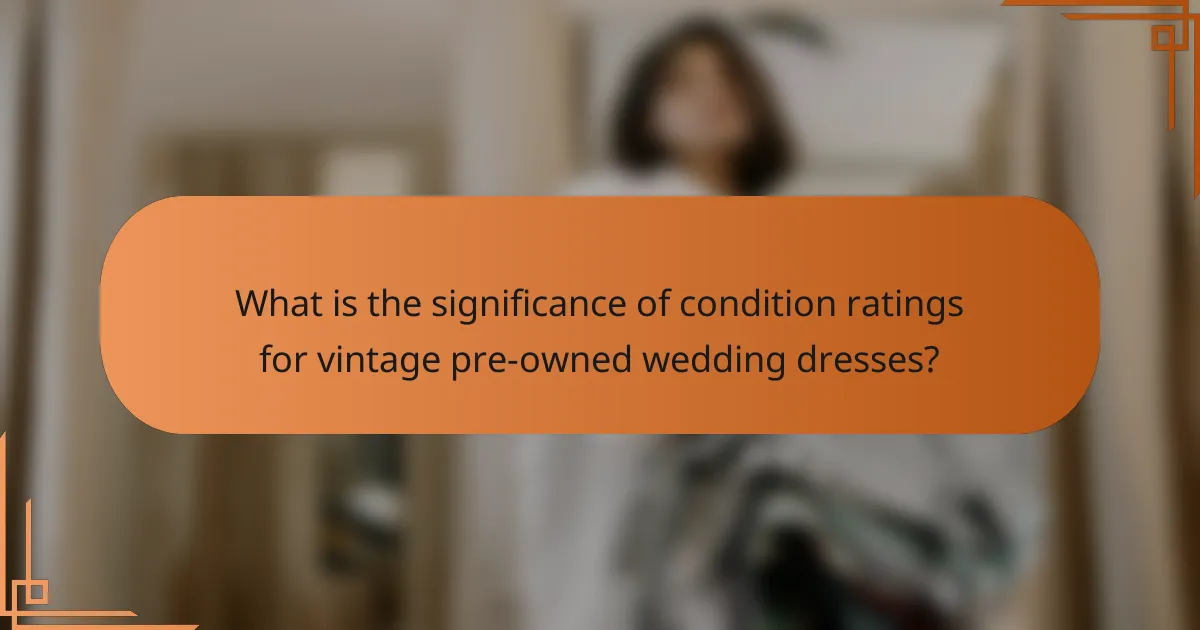
What is the significance of condition ratings for vintage pre-owned wedding dresses?
Condition ratings for vintage pre-owned wedding dresses indicate the dress’s state of wear and preservation. These ratings help buyers assess the quality and potential value of the dress. A higher condition rating typically suggests minimal wear, which can enhance the dress’s resale value. Conversely, lower ratings may indicate repairs or significant wear, affecting buyer interest and pricing. Accurate condition ratings also guide sellers in setting competitive prices. For instance, a dress rated as “excellent” may sell for 20-30% more than one rated as “good.” Thus, condition ratings are crucial for both buyers and sellers in the vintage wedding dress market.
How do we assess the condition of a vintage wedding dress?
To assess the condition of a vintage wedding dress, examine its fabric, seams, and embellishments. Inspect for discoloration, stains, or fading, which indicate age and wear. Check for any tears, fraying, or loose threads that may compromise integrity. Evaluate the condition of zippers, buttons, and closures for functionality. Assess the lining for any damage or deterioration, as this can affect overall quality. Document any repairs or alterations made to the dress, as these can impact value. Finally, consider the dress’s provenance, as a well-documented history can enhance its appeal and worth.
What are the common condition ratings used in the market?
Common condition ratings used in the market for vintage pre-owned wedding dresses include Excellent, Very Good, Good, Fair, and Poor. Excellent indicates minimal signs of wear and no flaws. Very Good signifies minor imperfections that are not easily noticeable. Good denotes visible signs of wear but is still wearable. Fair suggests significant wear and may require repairs. Poor indicates heavy damage or extensive wear, often unsuitable for immediate use. These ratings help buyers assess the quality and value of the dresses.
How does the condition affect resale value?
The condition of vintage pre-owned wedding dresses significantly impacts their resale value. Dresses in excellent condition typically command higher prices. Minor flaws may reduce value but can be acceptable if the dress is rare or highly sought after. Dresses with major damage often have a drastically lower resale value. For example, a dress with stains or tears may sell for 50% less than one in pristine condition. Buyers prioritize quality and appearance, leading to higher demand for well-maintained dresses. Thus, the condition is a key factor in determining resale prices in the vintage wedding dress market.
What should buyers look for when evaluating the condition of a vintage wedding dress?
Buyers should look for fabric integrity, stains, and repairs when evaluating the condition of a vintage wedding dress. The fabric should be free from significant tears or fraying. Discoloration or stains can indicate poor storage or age. Buyers should also check for any previous alterations. These alterations may affect the dress’s fit and value. Additionally, examine the lining and seams for signs of wear. A well-preserved dress typically has minimal signs of use. Authentic vintage dresses often have unique characteristics that enhance their value.
What are the key signs of wear and tear to check for?
Key signs of wear and tear to check for include fabric fraying, discoloration, and stains. Inspect seams for loose threads or unraveling. Check for missing embellishments like beads or lace. Look for signs of fading, especially in exposed areas. Examine the lining for wear or damage. Assess the overall structure for any distortions. These indicators can affect the dress’s value and condition rating. Regular maintenance can help preserve vintage wedding dresses.
How can buyers ensure they are making a wise investment?
Buyers can ensure they are making a wise investment by thoroughly researching the vintage pre-owned wedding dress market. Understanding price trends helps buyers identify fair pricing. Buyers should also consider the era of the dress, as certain styles may appreciate in value. Evaluating the condition ratings is crucial; dresses in excellent condition hold more value. Authenticity verification is important to confirm the dress’s origin. Buyers should seek reputable sellers with positive reviews. Consulting experts or appraisers can provide additional insights. Keeping records of purchase details can aid in future resale value.
What tips can help buyers navigate the vintage wedding dress market?
Buyers can navigate the vintage wedding dress market by researching dress styles and eras. Understanding the historical context of designs aids in identifying authentic pieces. Buyers should set a budget to filter options effectively. Inspecting the dress for condition and any repairs is crucial. Authenticity can be verified through labels and tags. Engaging with reputable sellers ensures trustworthiness. Utilizing online platforms and vintage shops broadens search options. Joining vintage fashion communities can provide valuable insights and recommendations.
Vintage pre-owned wedding dresses are defined as bridal gowns that are at least 20 to 30 years old, showcasing unique styles and craftsmanship from specific historical periods. This article examines the factors influencing their pricing, including the dress’s era, designer, condition, and rarity, as well as the growing popularity of pre-owned options due to sustainability and affordability. Key sections cover the characteristics that distinguish vintage dresses from modern ones, the significance of condition ratings, and current market trends affecting their value. Overall, the content provides a comprehensive overview of the vintage wedding dress market, highlighting essential attributes and insights for potential buyers.
